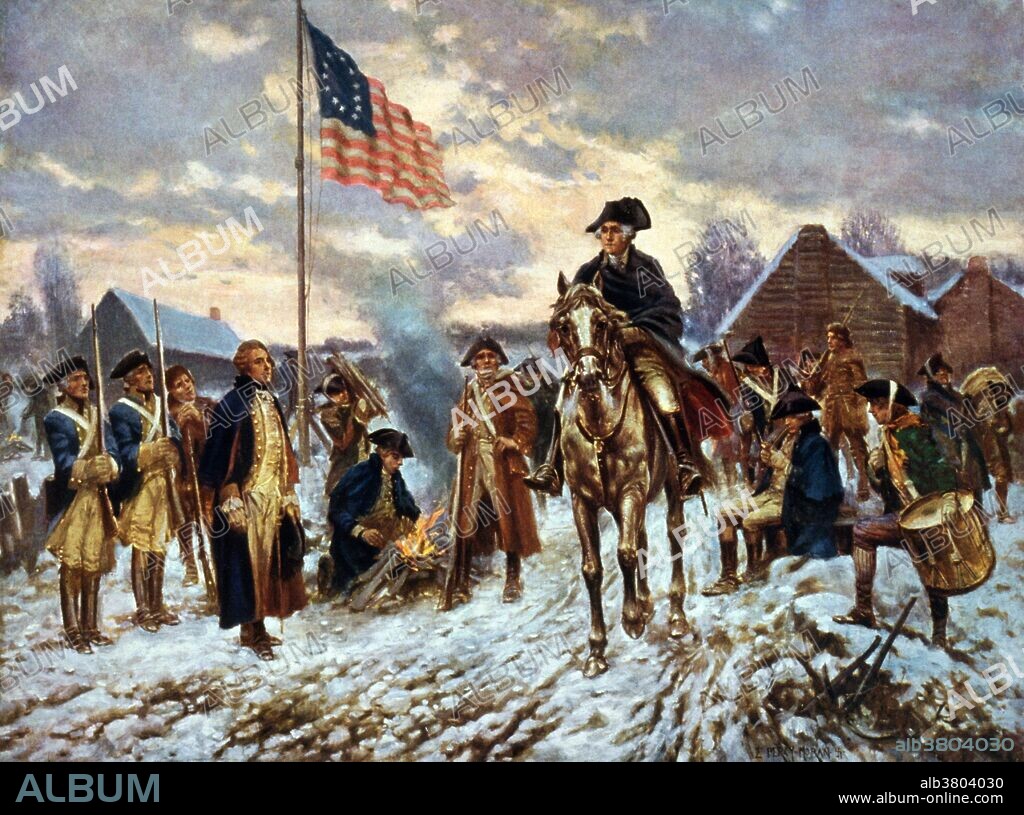alb3804030
George Washington at Valley Forge, 1777-78

|
Añadir a otro lightbox |
|
Añadir a otro lightbox |



¿Ya tienes cuenta? Iniciar sesión
¿No tienes cuenta? Regístrate
Compra esta imagen.
Selecciona el uso:

Título:
George Washington at Valley Forge, 1777-78
Descripción:
Traducción automática: Titulado: "Washington en Valley Forge" que muestra a Washington a caballo en la nieve en Valley Forge. Valley Forge era el campamento militar en el sureste de Pensilvania, aproximadamente a 20 millas al noroeste de Filadelfia, donde el Ejército Continental Americano pasó el invierno de 1777-78 durante la Guerra Revolucionaria Americana. El hambre, las enfermedades, la desnutrición y la exposición mataron a más de 2.500 soldados estadounidenses a finales de febrero de 1778. Con el invierno casi llegando y las perspectivas de hacer campaña disminuyendo considerablemente, el general George Washington buscó alojamiento para sus hombres. Washington y sus tropas habían librado lo que sería el último enfrentamiento importante de 1777 en la batalla de White Marsh (o Edge Hill) a principios de diciembre. Ideó sacar a sus tropas de su campamento actual en el área de White Marsh (ahora Parque Estatal Fort Washington) y trasladarlas a un lugar más seguro para el próximo invierno. Los seguidores del campamento en Valley Forge estaban formados por las esposas, hijos, madres y hermanas de los soldados. Estos seguidores del campo a menudo servían como lavanderas, limpiando y remendando los uniformes de los soldados. Reproducción de pintura de E. Percy Moran.
Entitled: "Washington at Valley Forge" showing Washington on horseback in snow at Valley Forge. Valley Forge was the military camp in southeastern Pennsylvania, approximately 20 miles northwest of Philadelphia, where the American Continental Army spent the winter of 1777-78 during the American Revolutionary War. Starvation, disease, malnutrition, and exposure killed over 2,500 American soldiers by the end of February 1778. With winter almost setting in, and with the prospects for campaigning greatly diminishing, General George Washington sought quarters for his men. Washington and his troops had fought what was to be the last major engagement of 1777 at the Battle of White Marsh (or Edge Hill) in early December. He devised to pull his troops from their present encampment in the White Marsh area (now Fort Washington State Park) and move to a more secure location for the coming winter. Camp followers at Valley Forge consisted of the wives, children, mothers, and sisters of the soldiers. These camp followers often served as laundresses, cleaning and mending the uniforms of the soldiers. Reproduction of painting by E. Percy Moran.
Personas:
Crédito:
Album / LOC/Science Source
Autorizaciones:
Tamaño imagen:
4350 x 3238 px | 40.3 MB
Tamaño impresión:
36.8 x 27.4 cm | 14.5 x 10.8 in (300 dpi)
Palabras clave:
1777 • 1778 • A CABALLO • ACAMPAR • ACONTECIMIENTO • AMERICA • AMERICANO • ARTE • CAMPAMENTO MILITAR • CAMPAMENTO • COLONIAL • COMANDANTE EN JEFE • CORONEL • ESTADOS UNIDOS DE AMERICA • ESTADOS UNIDOS • FAMOSA • FAMOSO • FIGURA • FORTALEZA • FUNCIONARIO • GENERAL • GENTE • GEORGE WASHINGTON • GOBIERNO • GUERRA • HEROE • HISTORIA • HISTORICO • HOMBRE • HOMBRES • ICÓNICO • IMPORTANTE • LIDER • MASCULINO • MILITAR • OBRA DE ARTE • OFICIAL • PADRE FUNDADOR • PENSILVANIA • PERCY MORAN • PERSONA • PERSONALIDAD • PERSONALIDADES • PINTURA • POLITICA • POPULAR • PRESIDENTE • RETRATO DE HOMBRE • S. XVIII • SIGLO XVIII • SOLDADO • WASHINGTON
 Pinterest
Pinterest Twitter
Twitter Facebook
Facebook Copiar enlace
Copiar enlace Email
Email
